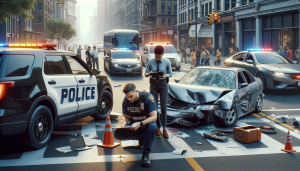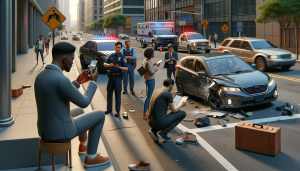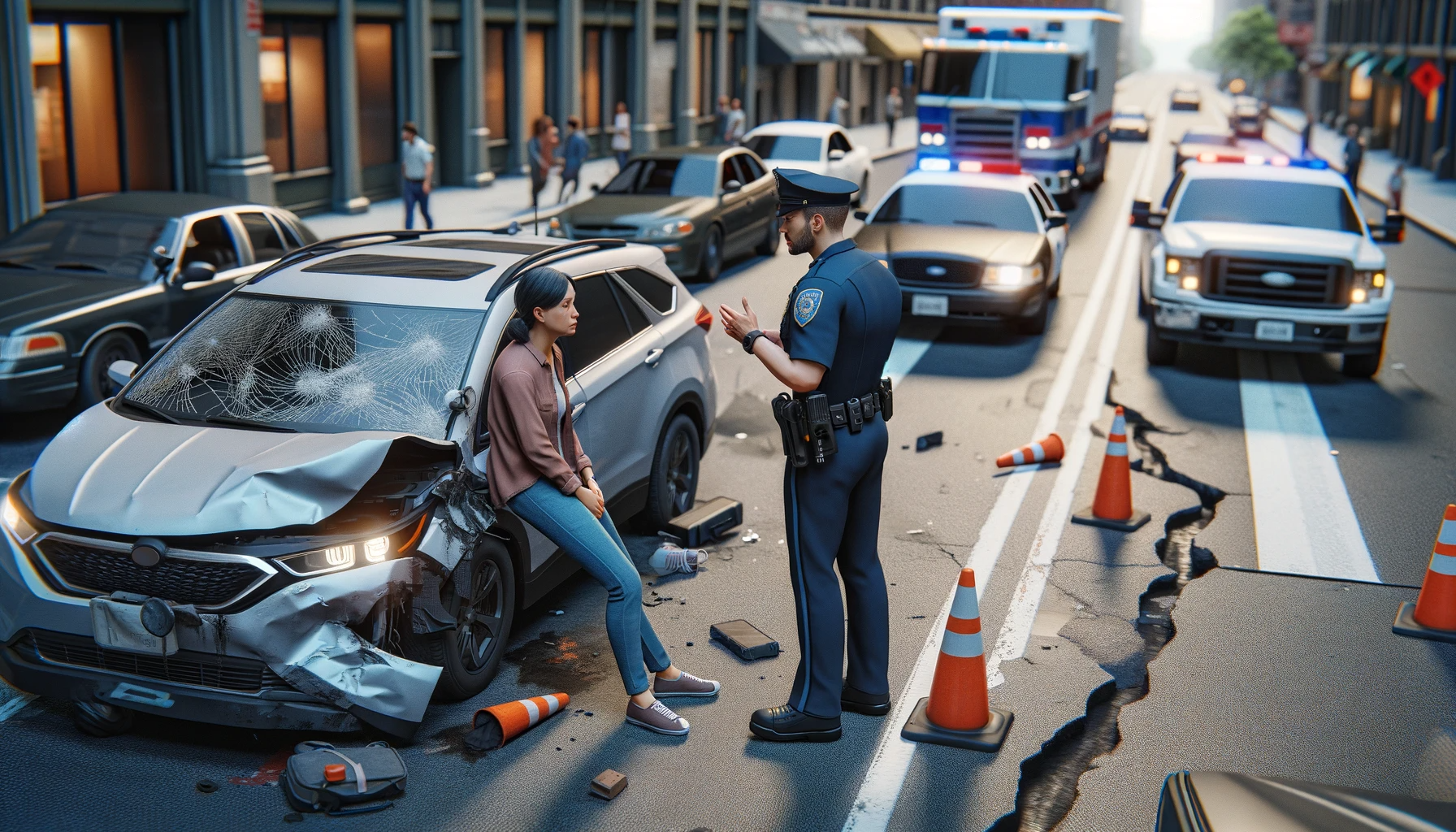Introduction
Picture yourself borrowing a friend’s car to run a quick errand, feeling confident and responsible, only for an unexpected accident to occur. In a flash, your simple favor transforms into a complex situation that leaves you wondering about responsibilities, liabilities, and insurance coverage. While no one anticipates such incidents, being prepared and informed about the steps to take and the legal considerations can significantly reduce the stress involved in handling a borrowed
car accident. This guide aims to equip you with essential knowledge, from understanding various types of insurance coverages to clarifying liability, allowing you to approach the situation calmly and with confidence.
Understanding Borrowed Cars and Liability
When it comes to accidents involving borrowed cars, liability can be a complicated area, influenced by factors such as ownership, insurance, and specific circumstances surrounding the accident. Generally, liability tends to rest with the vehicle’s owner, given that insurance is usually linked to the car rather than the driver. However, in some cases, the driver can also bear responsibility, especially if negligence, unlawful activities, or lack of proper licensing are involved. Being aware of these distinctions can help prevent misunderstandings and streamline the process, should you find yourself in a borrowed
car accident.
- Owner’s Liability: The car owner’s insurance policy often serves as the primary coverage in the event of an accident. This means the insurance will generally cover the damages first, regardless of whether the owner or another driver was behind the wheel.
- Driver’s Liability: In some situations, liability can shift to the driver, especially if they were found to be engaging in reckless or illegal behavior, such as driving under the influence. Additionally, if the driver was unlicensed or had permission only from a secondary owner, this could further complicate the liability question.
- Shared Liability Scenarios: In rare cases, both the car owner and the driver could share liability. For instance, if the car was knowingly lent out with mechanical issues, and the accident resulted from these problems, the owner could share responsibility.

The Role of Car Insurance in Borrowed Vehicle Accidents
Insurance is one of the most critical factors in determining who pays for damages in the event of a borrowed
car accident. Typically, the car owner’s insurance policy acts as the primary coverage, which means it will address claims first. However, if the damages exceed the policy’s limit, the borrower’s insurance may serve as secondary coverage. Each insurance type offers different protections, and understanding them can help clarify your potential financial responsibilities.
- Primary Coverage through Owner’s Insurance: The owner's insurance usually provides the primary coverage. This setup often simplifies the process for the borrower, as the owner’s insurer will manage the majority of claims. Still, it’s important to confirm with the car owner about their insurance details, especially to avoid unexpected expenses.
- Secondary Coverage through Borrower’s Insurance: If the damages surpass the car owner’s coverage limits, the borrower’s insurance may cover the remaining costs. This secondary coverage is essential, especially in significant accidents, and is generally limited to the borrower’s liability or other optional coverages.
Types of Insurance That May Cover a Borrowed Car Accident
The insurance types relevant to borrowed
car accidents vary based on the coverage the owner and borrower carry. Here’s a closer look at the primary coverages that could come into play:
- Liability Insurance: This essential insurance covers damages and injuries to others when you are at fault in an accident. With a borrowed car, the car owner’s liability insurance will usually cover the initial costs. However, if the damages exceed the policy’s limits, the borrower’s liability insurance may step in to fill the gap, especially if the driver’s fault in the accident is established.
- Collision Insurance: In the event of damage to the borrowed car, collision insurance is what helps cover the repair costs, regardless of fault. Since not all insurance policies include collision coverage, it’s essential to check with the car owner before borrowing to understand if this type of coverage is available. Without it, the borrower could be personally responsible for any repair costs to the car.
- Comprehensive Coverage: This insurance type covers non-collision-related incidents, such as theft, vandalism, or weather damage. Comprehensive coverage is crucial if the accident didn’t involve another vehicle—for instance, if a tree branch fell on the car. Again, verifying with the owner about this coverage is essential, as not all insurance policies offer it.
- Uninsured/Underinsured Motorist Coverage: If the other party involved in the accident lacks adequate insurance, this type of coverage can protect both the owner and borrower from bearing significant expenses. It’s especially helpful if the accident was caused by an uninsured or underinsured driver, allowing damages to be covered even if the at-fault party can’t pay.
Primary Insurance Coverage for Borrowed Car Accidents
In most scenarios, the car owner’s insurance serves as the primary coverage in a borrowed
car accident, meaning that the owner’s policy will handle the bulk of claims and costs before tapping into any coverage from the borrower. This arrangement can alleviate financial stress for the borrower, as the car owner’s insurance typically absorbs most initial costs. However, it’s still wise to confirm details with the car owner beforehand, including the extent of coverage, deductibles, and any potential out-of-pocket expenses the borrower might incur.
- Confirm Coverage Limits and Deductibles: Understanding the owner’s insurance policy, especially coverage limits and deductibles, can prevent surprises. The borrower should know whether they may be liable for deductibles or other expenses not fully covered by insurance.
- Clarify Potential Additional Costs: Even with primary insurance coverage, some scenarios can leave both the owner and borrower with additional expenses. For example, if the accident results in damages exceeding the policy’s limits, the borrower’s insurance may step in, or the borrower may need to cover the difference out-of-pocket.
- Know When Borrower’s Insurance May Apply: Secondary coverage typically applies only when damages exceed the owner’s policy limits. However, some insurance policies exclude certain drivers or scenarios. It’s beneficial for both the owner and borrower to understand these details before lending or borrowing the car.
Secondary Insurance Coverage in Borrowed Car Accidents
When involved in an accident in a borrowed car, the borrower’s insurance may serve as secondary coverage. Typically, the primary responsibility for covering accident costs falls to the car owner's insurance policy. However, when damages surpass the limits of the owner's policy, the borrower’s insurance can become secondary coverage, stepping in to handle additional expenses. This arrangement helps protect both parties from unexpected financial burdens, yet it can vary based on state laws and individual policy terms. Consulting an insurance representative is essential for understanding how your coverage may be applied in the event of a borrowed
car accident.
- Understanding the Borrower’s Policy Limits: Every insurance policy has specific limits, and understanding the maximum coverage provided by your own insurance as a borrower is key. If your secondary insurance kicks in, knowing your coverage limits can help anticipate the portion of expenses it will cover.
- Coordination Between Primary and Secondary Insurances: If your insurance acts as secondary coverage, coordination between the owner’s insurer and your insurer becomes crucial. This can help in accurately assessing the damages and ensuring a smooth claims process for both parties.
- Different Insurance Providers’ Policies: Some insurers have particular conditions regarding secondary coverage. Knowing your own policy’s provisions and exclusions will prepare you for how your insurer might respond.
Exclusions and Limitations in Insurance Policies
Not all insurance policies automatically cover accidents that occur in a borrowed vehicle. It’s essential to understand common exclusions to avoid surprises in the event of a claim denial:
- Unauthorized Use: If you borrow a car without explicit permission from the owner, insurance policies might refuse to cover the accident. This exclusion generally applies if the vehicle was borrowed without consent or if the driver doesn’t have express authorization to use the car.
- Unlicensed Drivers: Driving without a valid license typically voids any insurance coverage, whether it’s the owner’s or the borrower’s policy. Insurers require licensed drivers to ensure responsible operation of the vehicle, and failure to comply may nullify coverage.
- High-Risk Drivers: Borrowers classified as high-risk, due to factors such as a history of accidents or traffic violations, may face exclusions from certain insurers. Owners should check their policies if they plan to lend their car to a driver who might fall under this category.
- Commercial Use Exclusion: If the borrower used the car for business purposes without the owner’s knowledge, some policies may exclude coverage for accidents resulting from commercial activities. Clarifying intended use can avoid this limitation.
Steps to Take Immediately After a Borrowed Car Accident
An accident can be chaotic, especially in a borrowed vehicle. Following these essential steps can protect your safety and ensure proper handling of the situation:
- Ensure Safety First: Immediately call emergency services to check for injuries and get assistance. Prioritizing safety can prevent further harm and ensures medical care is promptly available.
- Document the Scene: Take photos of the accident scene, vehicle damages, and any visible injuries. Additionally, gather contact information from all involved parties and any witnesses. This documentation will be valuable for insurance claims and potential legal proceedings.
- Contact Insurance Providers: Both you and the car owner should contact your respective insurers as soon as possible to inform them about the accident. Quick communication can help speed up the claims process and prevent misunderstandings or delays.
Legal Liability and the Borrower’s Responsibility
In certain situations, the borrower may face personal liability for an accident, particularly if they exhibited reckless behavior or engaged in illegal activities while driving. Recklessness, such as driving under the influence or engaging in distracted driving, could result in financial responsibilities extending beyond what insurance covers. This can include:
- Reckless or Negligent Driving: If the accident resulted from risky behaviors like speeding or distracted driving, the borrower could be held liable for additional damages.
- Intoxication or Impairment: Driving while under the influence is a serious offense that often voids insurance coverage and imposes personal liability. The borrower may be financially responsible for all damages in this case, and may also face criminal charges.
Understanding these potential consequences encourages safe, responsible driving and ensures that borrowers recognize the personal risks involved.
The Vehicle Owner’s Legal Liability
There are instances where the car owner could share in the liability of an accident involving their vehicle. This might happen under certain circumstances:
- Lending the Car to an Unqualified Driver: If the owner knowingly allows an unlicensed or otherwise unqualified driver to borrow their car, they may share in the legal liability for any resulting accidents. This shared responsibility could also complicate the insurance claims process.
- Negligence in Vehicle Maintenance: If the accident stemmed from a mechanical failure due to the owner’s negligence in maintaining the vehicle, they might bear partial responsibility for the damages. For example, if worn brakes or faulty tires contributed to the incident, the owner could share liability.
What to Do If the Borrowed Car is Not Insured
Driving an uninsured borrowed car introduces additional risks and legal complications. In some states, the driver may be penalized even if they are not the car owner. Here’s what you can do:
- Consider Personal Insurance Options: In cases where your insurance policy allows, your own coverage may offer some protection even if the borrowed car itself is uninsured. Discussing this option with your insurer ahead of time can help you understand your protection levels.
- Seek Legal Assistance: Consulting a lawyer can be invaluable when dealing with accidents involving an uninsured borrowed car. They can advise on your rights, potential liabilities, and the best course of action based on local laws.
Working with Insurance Adjusters
After an accident, you may be contacted by an insurance adjuster. Here are some tips to manage these discussions:
- Stick to Facts and Avoid Admitting Fault: Provide accurate information but refrain from speculating about the cause of the accident or admitting fault. Adjusters assess claims objectively, and oversharing can potentially influence the outcome.
- Be Transparent but Cautious: Answer questions clearly but avoid offering additional information unless requested. This ensures that you only share relevant details and helps maintain focus on the critical aspects of your claim.
- Seek Legal Advice if Necessary: If the insurance process feels complex or if you sense complications, consulting with a legal advisor can clarify your rights and protect your interests. An attorney can also communicate with adjusters on your behalf, ensuring your rights are safeguarded.

Seeking Legal Advice for Borrowed Car Accidents
Legal advice can often make a significant difference in cases involving borrowed
car accidents. Here’s how a legal expert can help:
- Determining Liability: An experienced attorney can evaluate the accident’s circumstances and establish who is liable. This can help resolve disputes between the borrower, the owner, and insurers.
- Protecting Your Rights: In insurance negotiations, legal counsel ensures your rights are upheld and that you receive fair treatment. They can also clarify complex policy terms and any exclusions that might affect your claim.
- Guidance on Covering Expenses: In situations where insurance doesn’t cover all damages, a lawyer can explore other avenues for recovery or reduction of out-of-pocket expenses.
Legal Resources and Support Organizations
Numerous organizations provide support and resources for those involved in
car accidents, including borrowed vehicle incidents. Some helpful organizations include:
- National Highway Traffic Safety Administration (NHTSA): The NHTSA offers valuable resources on traffic laws and safety tips that can inform your legal strategy following an accident.
- American Bar Association (ABA): The ABA can connect you with reputable legal experts, including those specializing in auto accidents and insurance disputes.
- Local Legal Aid Services: Many states provide legal aid services that offer free or low-cost assistance for auto accident cases. These organizations can be instrumental if you need help but are concerned about legal costs.
Conclusion
Experiencing an accident in a borrowed car can be overwhelming, but a solid understanding of insurance coverages, liability issues, and the legal resources available can significantly ease the burden. Remember to prioritize safety, document the incident thoroughly, and communicate with insurers promptly to ensure an efficient claims process. Seeking legal advice can be particularly valuable in protecting your rights and navigating the complexities of liability. By taking these steps, you can confidently manage the situation, safeguard your financial well-being, and protect both yourself and the car owner from unnecessary complications.
Look for an attorney who has the right legal resources for your legal needs.
Contact us here on the
Warmuth Law website or through our hotline 888-517-9888.
Frequently Asked Questions (FAQ's)
1. Who is liable if I crash a borrowed car?
Typically, the car owner’s insurance is responsible first. However, the borrower might be liable if damages exceed the owner’s coverage.
2. What if the borrowed car doesn’t have insurance?
You could face legal consequences if caught driving an uninsured car. Check with your own insurer, as some policies extend to borrowed vehicles.
3. Do I need my own insurance to drive someone else’s car?
Not necessarily, but having your own insurance may act as secondary coverage if an accident occurs.
4. Can insurance deny coverage for a borrowed car accident?
Yes, insurance can deny coverage if the borrower didn’t have permission or was under the influence.
5. When should I consult a lawyer?
It’s wise to consult a lawyer if liability is unclear or if insurance isn’t covering the full cost of damages.













